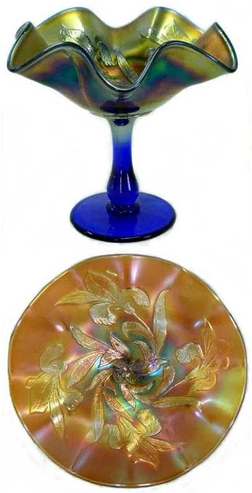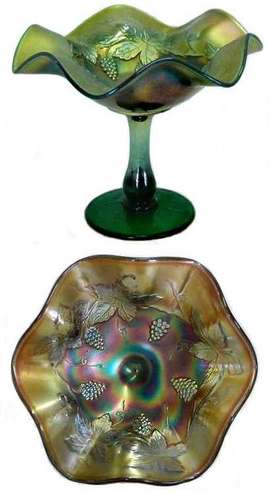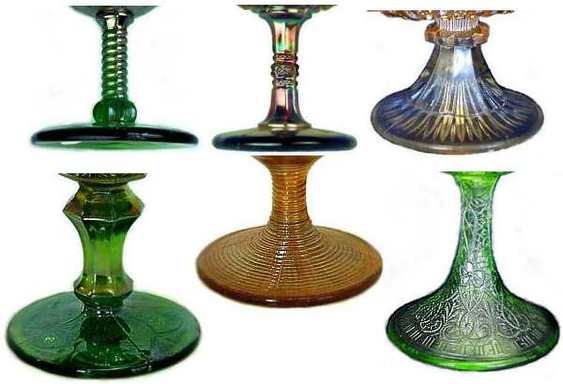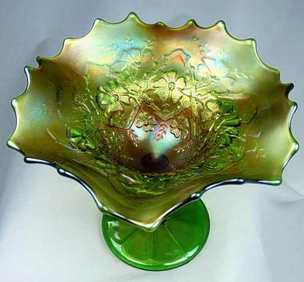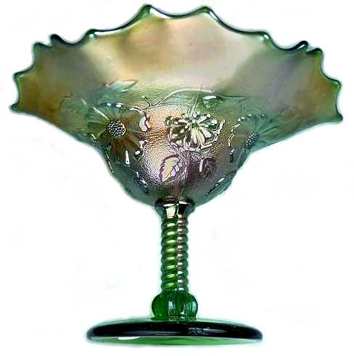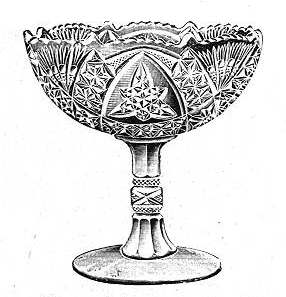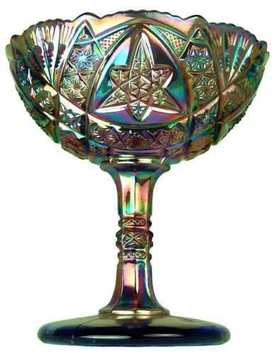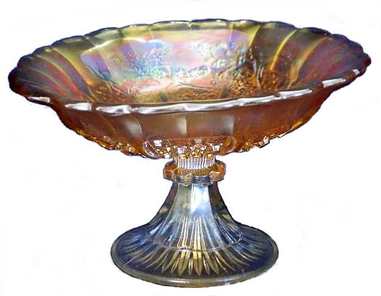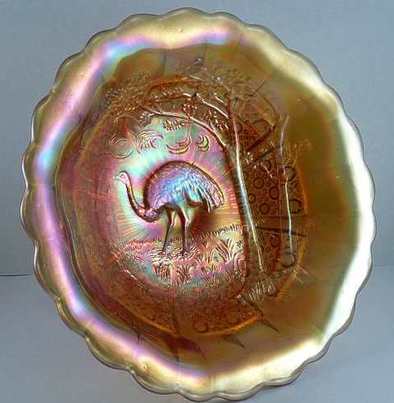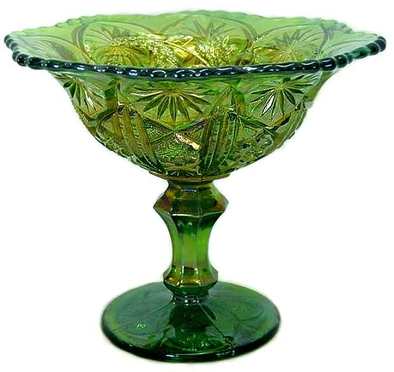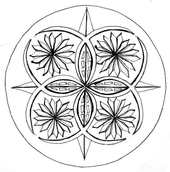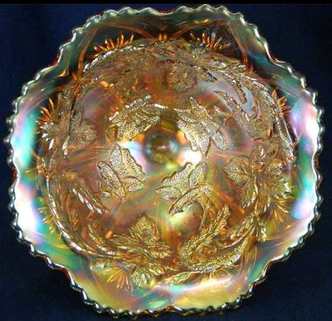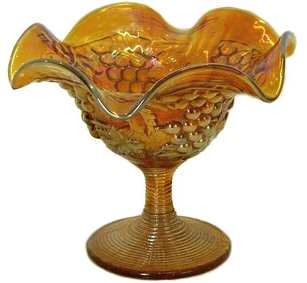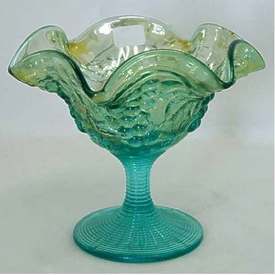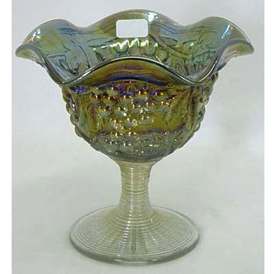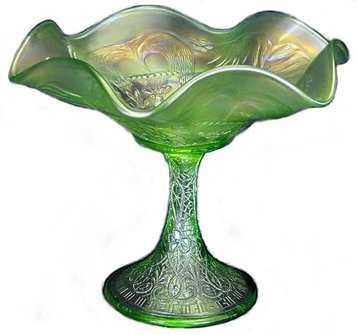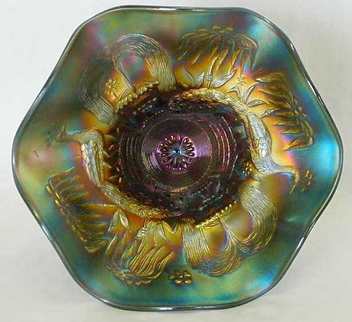Comports!
Ten cents for “this beautiful iridescent glass vase”! The above ad was in a 1908 issue of the “Washington Evening Star”, and it caught our eye for several reasons: it isn’t what we traditionally refer to as a vase, of course, it’s a comport (also called compote).
|
So, let’s start right there … what exactly is a comport / compote?
A comport (also called compote and originally a comportier) is a dish with a long stem and a base (plus in some instances a lid too) that could be used to serve nuts, fruits, jellies and confections. Not only were comports useful and multi-purpose items, they were often very decorative, and were made in many different sizes, patterns and finishes. As we see in the ad shown above, they were also marketed to be used as vases. As we gazed at the ad for this particular piece, we wondered: What pattern might be hidden inside? Was there a way of figuring it out? Then we looked at the stem, with its distinctive shape and profile. There’s the clue! That distinctively shaped stem fits these two comports from Fenton: Iris and Vintage. Shown on the right, pictures courtesy of Seeck Auctions, are an Iris comport (blue) and pattern detail (marigold); Vintage comport (green) and pattern detail (amethyst). |
|
Distinctive Stems?
The distinctive shape and profile of the comport shown in the ad above made us think about other comports. Are the stems of many others comports so characteristic and individual that it’s possible to figure out what the pattern is by seeing only the stem? Do you recognise the distinctive stems on the right from a variety of comports Here is the identification: Top row, left to right: Blossomtime (Northwood), Curved Star (Brockwitz), Emu (Crown Crystal). Bottom row, left to right: Poppy (Millersburg), Imperial Grape (Imperial), Peacock at the Fountain (Northwood). |
Here they all are in detail.
Blossomtime, Northwood
The interior pattern is called Blossomtime, while the distinctive exterior design is known as Wild Flower. The threaded-effect stem is an easily recognisable characteristic of this comport, which stands around 5 inches high.
Blossomtime, Northwood
The interior pattern is called Blossomtime, while the distinctive exterior design is known as Wild Flower. The threaded-effect stem is an easily recognisable characteristic of this comport, which stands around 5 inches high.
|
Note that the comport with the Wild Flower exterior and its distinctive stem, is also known with a plain interior, when it would be referred to as the Wild Flower comport. The Blossomtime comport is also known with a plain exterior (see Carl Burns “Northwood Carnival Glass”). |
Curved Star, Brockwitz
|
There are several sizes of comports (actually stemmed sugars) in this pattern from Brockwitz – the one on the right is the smallest known in Carnival, standing 4.5 inches high. The Curved Star pattern is shown on the exterior, while the interior is plain; the stem has a very distinctive design half way up.
|
Emu, Crown Crystal
|
The diameter of the base of this very distinctive stem is around 5 inches; on the base of the foot is a star made up of 24 large points and 24 small points (you can see it in the photo). The Hobnail pattern is on the exterior of the top part of the comport. The Emu may be pulled up into the comport form, or made flatter (and thus lower) as a salver. Other large comports from Crown Crystal, such as Butterfly and Waratah, are known with a similar, but somewhat taller, distinctive stem. Photos courtesy Wilma and Neil Berry.
|
|
Poppy, Millersburg
The stem on Millersburg's Poppy comport has a very recognisable profile. The comport is 7 inches tall, and is known both cupped up and also flattened like a salver. The Poppy interior is matched with their Potpourri exterior – a product of Millersburg’s artistically brilliant, but commercially disastrous policy of creating multiple, complex exterior designs to match specific interior patterns. Millersburg's Cherries comport also has the same shaped stem. See all of Millersburg's amazing exterior patterns in Millersburg's Masterpieces |
Pictures courtesy of Seeck Auctions.
Imperial Grape, Imperial
Modest pieces, affordable in a range of colours, but what a stunning and unique horizontally ribbed stem these comports have. A perfect example of an affordable piece of beauty. The comport is shaped from the goblet mould which means that the ruffling will vary from one piece to another - the smoke example on the right, below, shows ruffling that is far less deep than the more usual ruffling seen on the amber and aqua examples.
All pictures are courtesy of Seeck Auctions.
Modest pieces, affordable in a range of colours, but what a stunning and unique horizontally ribbed stem these comports have. A perfect example of an affordable piece of beauty. The comport is shaped from the goblet mould which means that the ruffling will vary from one piece to another - the smoke example on the right, below, shows ruffling that is far less deep than the more usual ruffling seen on the amber and aqua examples.
All pictures are courtesy of Seeck Auctions.
Peacock at the Fountain, Northwood
At first glance, upon seeing the Hearts and Flowers pattern down the stem, one’s first thought is likely to be that this is surely a Hearts and Flowers comport. In fact it’s not – this is Northwood’s Peacock at the Fountain comport, which also has the Hearts and Flowers design on the stem.
At first glance, upon seeing the Hearts and Flowers pattern down the stem, one’s first thought is likely to be that this is surely a Hearts and Flowers comport. In fact it’s not – this is Northwood’s Peacock at the Fountain comport, which also has the Hearts and Flowers design on the stem.
Further Reading: A long-standing debate about the "correct" terminology: "Comport or Compote - that is the question!"

